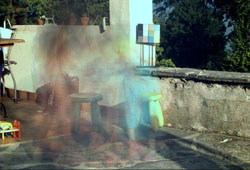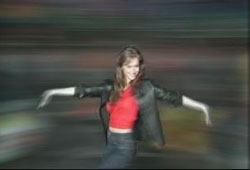TECHNIQUES - SPACE BLUR
Space blur is similar to time blur but on the spatial axis. Space blur looks like motion blur resulting from movement of the camera (see example to the right below).
With a single still camera space blur can be captured by moving the camera during the exposure. But with Digital Air's systems the individual cameras within the system are not necessarily moving, moreover, if the subject is a frozen moment there is usually no time to move the cameras. As a result space blur generally requires the use of interpolation.
Because any number of frames (camera positions) can be interpolated to create space blur the effect can range anywhere from barely noticeable to infinitely extreme. As a result shots can blur in and out to such a degree that their subjects completely disappear and reappear.
Objects placed at the nodal point of a curved camera system will tend to remain relatively sharp even when extreme space blur is applied. You can see this in the image to the right. This was shot with our 80 lens curved Timetrack™ camera and all 80 frames were interpolated to make this one image. This contrast between blurred background and sharp subject can be amplified by compositing a sharp base-line raw image sequence of the subject (the green frames in the graphic below) over a space blurred background plate (the yellow frames below interpolated together across space).
| |

time blur
(temporal motion blur with no spatial component)

space blur
(spatial motion blur with no temporal component)
|